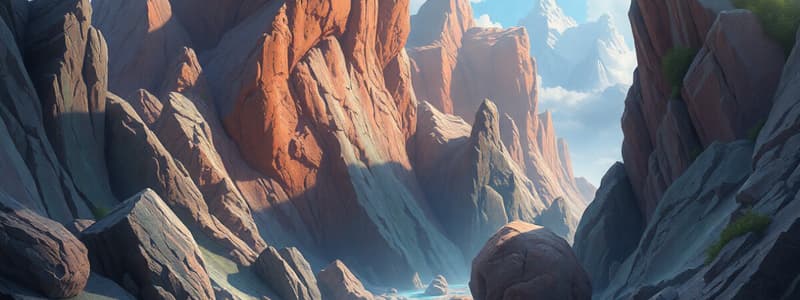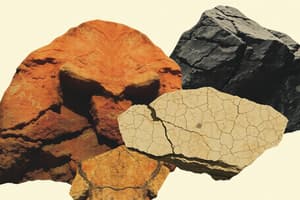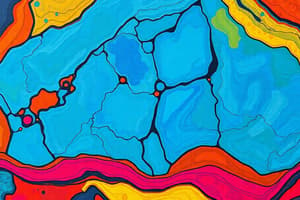Podcast
Questions and Answers
Granite is an intrusive igneous rock that forms when magma cools quickly.
Granite is an intrusive igneous rock that forms when magma cools quickly.
False (B)
Which of these is NOT a mineral found in granite?
Which of these is NOT a mineral found in granite?
- Feldspar
- Mica
- Quartz
- Limestone (correct)
Describe the texture of basalt.
Describe the texture of basalt.
Basalt has a smooth texture.
The Giant's Causeway, a famous geological formation, is made up of the igneous rock ______.
The Giant's Causeway, a famous geological formation, is made up of the igneous rock ______.
Match the following rock types with their formation processes:
Match the following rock types with their formation processes:
Explain why sedimentary rocks are often found in layers called strata.
Explain why sedimentary rocks are often found in layers called strata.
Which of these is a common use for crushed basalt?
Which of these is a common use for crushed basalt?
Sedimentary rocks make up the majority of rocks at the Earth's surface.
Sedimentary rocks make up the majority of rocks at the Earth's surface.
Which of the following minerals can be accessed through shaft mining?
Which of the following minerals can be accessed through shaft mining?
Shaft mining is a process that only involves drilling horizontally into the earth.
Shaft mining is a process that only involves drilling horizontally into the earth.
Which of the following describes minerals?
Which of the following describes minerals?
What are two potential environmental impacts of shaft mining?
What are two potential environmental impacts of shaft mining?
The Tara Lead and Zinc Mines in Co. Meath employs ______ people directly.
The Tara Lead and Zinc Mines in Co. Meath employs ______ people directly.
Rocks are divided into two groups based on their origin: igneous and sedimentary.
Rocks are divided into two groups based on their origin: igneous and sedimentary.
What is the name of the process where rocks are constantly changing?
What is the name of the process where rocks are constantly changing?
Match the following mining types with their descriptions:
Match the following mining types with their descriptions:
What is the main use of the land surrounding the Galmoy mines?
What is the main use of the land surrounding the Galmoy mines?
Magma that cools slowly below the Earth's surface is known as ______ rock.
Magma that cools slowly below the Earth's surface is known as ______ rock.
The Galmoy mines were permanently closed in 2014.
The Galmoy mines were permanently closed in 2014.
Match the following terms with their definitions:
Match the following terms with their definitions:
Which of these is NOT a characteristic of rocks?
Which of these is NOT a characteristic of rocks?
What positive environmental impact was observed after the closure of the Galmoy mines?
What positive environmental impact was observed after the closure of the Galmoy mines?
All rocks are made from a single mineral.
All rocks are made from a single mineral.
Besides being part of the landscape, what do rocks provide us with?
Besides being part of the landscape, what do rocks provide us with?
Which of the following is an example of an intrusive igneous rock?
Which of the following is an example of an intrusive igneous rock?
Extrusive igneous rocks are formed from magma that cools slowly beneath the Earth's surface.
Extrusive igneous rocks are formed from magma that cools slowly beneath the Earth's surface.
What process forms sedimentary rocks?
What process forms sedimentary rocks?
Metamorphic rocks are formed when igneous or sedimentary rocks are put under great ______ or pressure.
Metamorphic rocks are formed when igneous or sedimentary rocks are put under great ______ or pressure.
What is formed when magma reaches the surface and cools?
What is formed when magma reaches the surface and cools?
Match the rock type with its formation process:
Match the rock type with its formation process:
Give two examples of metamorphic rock.
Give two examples of metamorphic rock.
Granite is an example of an extrusive igneous rock.
Granite is an example of an extrusive igneous rock.
What is the main purpose of drilling?
What is the main purpose of drilling?
Quarrying is a process that takes place deep underground.
Quarrying is a process that takes place deep underground.
What are two potential environmental impacts of oil spills?
What are two potential environmental impacts of oil spills?
Quarrying is also known as ______ mining.
Quarrying is also known as ______ mining.
What percentage of Ireland's gas needs can the Corrib project potentially supply?
What percentage of Ireland's gas needs can the Corrib project potentially supply?
Quarrying only generates economic benefits and has no negative impacts.
Quarrying only generates economic benefits and has no negative impacts.
Approximately how many people are employed in quarrying in Ireland?
Approximately how many people are employed in quarrying in Ireland?
What type of rock is formed when sandstone comes under great heat and pressure?
What type of rock is formed when sandstone comes under great heat and pressure?
Quartzite is typically used in the production of jewellery.
Quartzite is typically used in the production of jewellery.
Name one way in which natural gas is used.
Name one way in which natural gas is used.
Gold is commonly used in __________.
Gold is commonly used in __________.
Which of the following is NOT a process involved in the formation of metamorphic rock?
Which of the following is NOT a process involved in the formation of metamorphic rock?
What is one economic consequence of human interaction with rocks?
What is one economic consequence of human interaction with rocks?
Match the materials to their uses:
Match the materials to their uses:
Gravel, stone and sands are used as __________ materials.
Gravel, stone and sands are used as __________ materials.
Flashcards
Quartzite Formation
Quartzite Formation
Formed from sandstone under heat and pressure, often during folding.
Uses of Quartzite
Uses of Quartzite
Used for road surfacing, in watches, and in glass production.
Metamorphic Rock
Metamorphic Rock
Rock transformed by heat, pressure, or chemically; example: quartzite.
Natural Resources
Natural Resources
Signup and view all the flashcards
Coal
Coal
Signup and view all the flashcards
Gold Uses
Gold Uses
Signup and view all the flashcards
Diamond
Diamond
Signup and view all the flashcards
Extraction Methods
Extraction Methods
Signup and view all the flashcards
Rock Cycle
Rock Cycle
Signup and view all the flashcards
Igneous Rocks
Igneous Rocks
Signup and view all the flashcards
Sedimentary Rocks
Sedimentary Rocks
Signup and view all the flashcards
Magma
Magma
Signup and view all the flashcards
Minerals
Minerals
Signup and view all the flashcards
Quarrying
Quarrying
Signup and view all the flashcards
Environmental Consequences of Mining
Environmental Consequences of Mining
Signup and view all the flashcards
Granite
Granite
Signup and view all the flashcards
Basalt
Basalt
Signup and view all the flashcards
Intrusive Igneous Rock
Intrusive Igneous Rock
Signup and view all the flashcards
Extrusive Igneous Rock
Extrusive Igneous Rock
Signup and view all the flashcards
Sandstone
Sandstone
Signup and view all the flashcards
Crystals
Crystals
Signup and view all the flashcards
Strata
Strata
Signup and view all the flashcards
Drilling
Drilling
Signup and view all the flashcards
Oil spills
Oil spills
Signup and view all the flashcards
Impact on wildlife
Impact on wildlife
Signup and view all the flashcards
Construction materials
Construction materials
Signup and view all the flashcards
Noise pollution
Noise pollution
Signup and view all the flashcards
Economic impact of quarrying
Economic impact of quarrying
Signup and view all the flashcards
Air pollution from quarrying
Air pollution from quarrying
Signup and view all the flashcards
Sedimentary Rock Formation
Sedimentary Rock Formation
Signup and view all the flashcards
Common Rock Types in Ireland
Common Rock Types in Ireland
Signup and view all the flashcards
Magma vs. Lava
Magma vs. Lava
Signup and view all the flashcards
Pressure in Rock Formation
Pressure in Rock Formation
Signup and view all the flashcards
Shaft Mining
Shaft Mining
Signup and view all the flashcards
Environmental Impacts
Environmental Impacts
Signup and view all the flashcards
Health Problems from Dust
Health Problems from Dust
Signup and view all the flashcards
Sinkholes
Sinkholes
Signup and view all the flashcards
Galmoy Mines
Galmoy Mines
Signup and view all the flashcards
Economic Impacts of Mining
Economic Impacts of Mining
Signup and view all the flashcards
Artificial Wetland
Artificial Wetland
Signup and view all the flashcards
Mineral Transport
Mineral Transport
Signup and view all the flashcards
Study Notes
Learning Intentions
- Students will be able to describe how each type of rock changes into another type as it moves through the rock cycle.
- Students will be able to name the three rock groups and provide examples of each.
- Students will be able to explain the formation of each rock group.
- Students will be able to describe how rocks are extracted and used, and evaluate the environmental, economic, and social consequences of rock exploitation.
- Students will be able to evaluate the environmental, economic, and social consequences of mining in the Galmoy Mine.
Key Words
- Mineral
- Rock cycle
- Permeable
- Compressed
- Intrusive
- Extrusive
- Crystals
- Strata
- Deposits
- Soluble
- Natural resources
- Drilling
- Quarrying
- Shaft mining
Uses of Rock
- Rocks are diverse in color, texture, hardness, and mineral content.
- Rocks can be made of a single mineral or multiple compressed minerals.
- Minerals are inorganic materials, not derived from animals or plants.
- Rocks form landscapes and provide essential resources.
Where Rocks Come From
- Examples of materials that come from rocks are: glass, slate, oil, bricks, copper, coal, iron ore, aggregate, marble, and silica.
The Rock Cycle
- Rocks are categorized into igneous, sedimentary, and metamorphic groups based on their formation.
- Rocks undergo constant change in a process known as the rock cycle.
Igneous Rocks
- Igneous rocks form from magma rising from the mantle.
- Intrusive igneous rocks form when magma cools slowly beneath the surface, creating large crystals (e.g., granite).
- Extrusive igneous rocks form when lava cools quickly at the surface, creating small crystals (e.g., basalt).
Sedimentary Rocks
- Sedimentary rocks are formed from fragments of other rocks, remains of plants and animals, or minerals precipitated from water.
- Layers of sediments are compressed and cemented together to form sedimentary rock (e.g., sandstone, limestone).
Metamorphic Rocks
- Metamorphic rocks form when igneous or sedimentary rocks are subjected to intense heat and pressure.
- This process transforms the original rock into a new, harder rock (e.g., marble, quartzite).
Human Interaction with Rocks
- Rocks provide crucial natural resources like oil, gas, coal.
- Rocks are mined by drilling, quarrying, and shaft mining.
Environmental Impact of Rock Exploitation
- Mining activities can cause pollution, soil erosion, and habitat destruction.
- Industrial discharge can harm aquatic ecosystems such as rivers and lakes.
- Air pollution from drilling and processing can lead to respiratory issues.
Social Impact of Rock Exploitation
- Mining jobs contribute to local economies but may cause displacement.
- Communities near mines might face noise pollution and traffic increase.
- The extraction of resources can threaten local natural landscapes and impact the local ecosystem.
Economic Impact of Rock Exploitation
- Mining generates income and revenue for both companies and the government.
- Many employment opportunities are created in various industries that depend on rocks for their raw materials.
- Mining projects can have significant financial consequences for companies and governments, if things go wrong, or the mine closes.
Case Study: Galmoy Mines
- Zinc, lead, and silver ore deposits exist in the Galmoy mines area.
- The mine operated from 1997 to 2014.
- The closing of the mine had negative consequences for local jobs and infrastructure.
- Positive consequences included the construction of a wetland area which encouraged wildlife growth.
- The area surrounding the mine is largely used for livestock grazing.
Sample Questions
- Students are asked to explain the formation of rocks.
- Students will be asked to explain the three different types of mining (drilling, quarrying, and shaft mining).
- Students will be asked to define different rock types, their formation, usage, or geographical location.
Studying That Suits You
Use AI to generate personalized quizzes and flashcards to suit your learning preferences.




